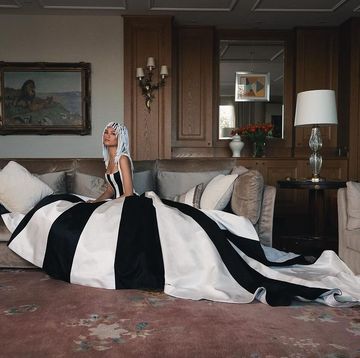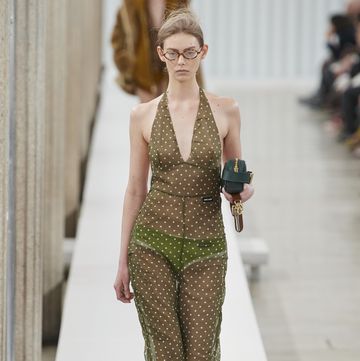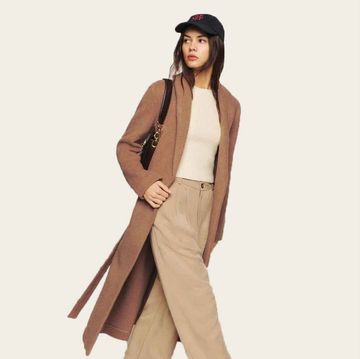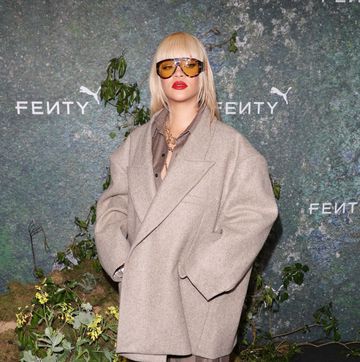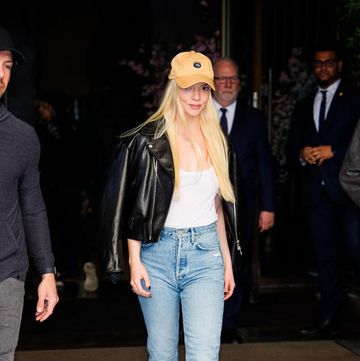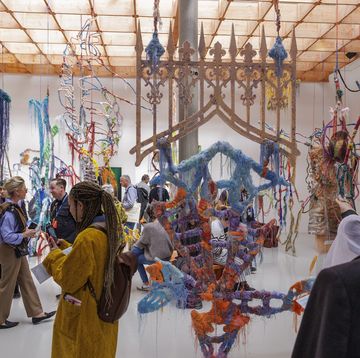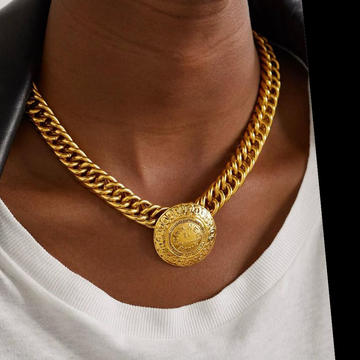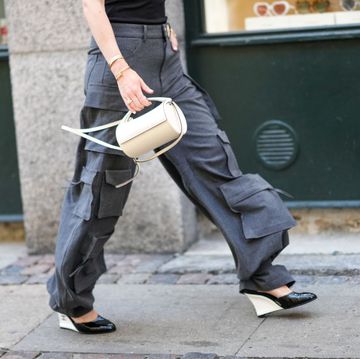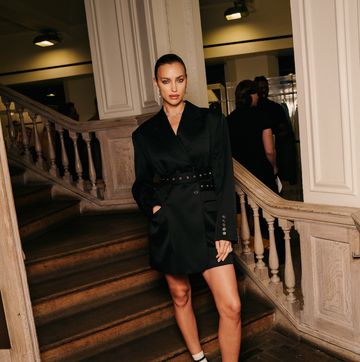‘Henry! Hen! Hen-reee!’ Alexa, Pixie and Daisy pile into Henry Holland backstage at his autumn/winter 2015 show. Excited, breathless, laughing, they jump on him, kiss him, hug him, lift him off his feet. He almost topples over; they almost fall with him. His most ardent long-time acolytes have just been whooping and grinding on a front-row bench to Uptown Funk, along with others of their ilk that form the usual House of Holland conveyor belt of celebrity. In front of them, ironically, motionless models stand on an airport-style travelator wearing punchy fuchsia maxi-checks, scarlet satin bomber jackets, black and yellow hazard stripes, rubber stockings and pale pink full-on fuzz resembling that of a poodle after a set and blow-dry. That was in February.
Cut to April: Henry Holland runs the 2015 London Marathon in an awe-inspiring three hours and 29 minutes, within the same 60 minutes as the nation’s long-distance running heroine Paula Radcliffe. The first thing he does, after drinking a gallon of water and collecting his medal, is take a selfie – knackered, sweaty, stringy haired, tongue lolling out – and posts it with the caption: ‘First and last post with no quiff. I did it… I’m fooked. Thank you all for sponsoring!!!’ Popular, crowd-pleasing, creative brand promoter on the one hand, fiercely focused self-believer with near super-human energy on the other. Both scenes say a lot about Henry, not least that you shouldn’t underestimate him.
I meet him in his new studio in Hackney, a vast three-floored space that is concrete proof of his burgeoning success. He is about to add a menswear line, employs 15 full-time members of staff, supplies 100 stockists worldwide, plus his own online shop. His company, which can boast a 20% increase year on year, is rapidly expanding in line with industry perception: it’s time to take fashion’s funny man seriously.
At 32, he says he has never had time to sit back and take stock, and I believe him. He is a doer with plans and goals; procrastination doesn’t enter his head. He has taken every chance encounter, every stroke of luck, and turned them to his advantage. And yet, sitting across from me, with his high-top quiff quivering, in a Comme des Garçons shirt printed with red-lipped mouths that would shout if they could, and the skinniest jeans and trainers, he says with a Northern twang: ‘There are still people who will never consider me as a proper designer.’
And there you have it, the chink of something, the hairline crack in confidence that is, I suspect, the motivation he thrives off to propel himself along. It is almost 10 years since he started out with a bunch of comedy slogan t-shirts and, despite turning them into a veritable fashion business, and time served (and, boy, is fashion a tough relentless business to be in, moving at warp speed and constantly weeding out the weak), Henry still feels he has much to prove.
His is not your average fashion story. Indeed, there is nothing average about Henry. He is not a Central Saint Martins alumnus. He didn’t even study fashion design; a fact that seems to bother him more than me or anyone else. Aged 19, he arrived in London to attend the London College Of Printing (now the London College Of Communication) and study journalism. He tried to switch to a fashion journalism course but it was too late, so with typical ‘screw that, I’m not wasting a year’ attitude, he found another way in. He started as an intern on the now-defunct weekly Sneak. ‘[It was] the teen version of Heat’, he laughs, ‘the lowest of the low in the fashion industry. Topshop wouldn’t lend samples. Our readers’ average age was 12 and three-quarters, with no disposable income, so all the fashion pages had to retail at £30 or less. I bloody loved it, though. Imagine: I had to find 57 coats for under £30!’
Girls Aloud were booked for the cover, but they wouldn’t let him style them. He ran fashion stories such as Get The Look, based on the Big Brother housemates, and Make Your Outfit Mum-Proof. At the same time, he got a gig on Smash Hits where he had a column called Henry Trendy featuring style tips such as: ‘Never wear black and blue together. Like, what are you, a bruise?’ And then he went to Bliss magazine, a monthly, as Deputy Fashion Editor, where he ran the website and wrote a scathing celebrity blog. He found himself at a loose end on a monthly: where he had been producing 24 pages a week for the weeklies, he was now in charge of 12 pages a month for Bliss, which gave him time to get some celebrity T-shirts printed up: Love Me Some Lohan and Buy This Coleen. He asked the fashion editor of Heat to put them on her page, ‘Anything in Heat was supposed to sell out in seconds, so I made 150 of each and sat by my phone waiting for my empire to take off.’ He sold six. Not that it deterred him.
By 2006, he was living in a flat in Chalk Farm, Camden, with his childhood friend, then model, now actress Agyness Deyn. ‘I met Henry when I was 12 years old,’ she recalls. Both grew up in Lancashire, attended different schools but met at the local hangout, a dry ski slope. ‘I remember thinking, “Wow, I’ve never met anyone like you.” He was so carefree and hilariously funny, he was like a new creature to me. When Henry moved to London, I missed him so much I followed him. He would sneak me into his halls of residence and we’d top ’n’ tail in a single bed eating paté on toast and fall asleep watching Friends. Then we lived together for years. Both of us were always skint; we’d feast on peas and gravy and make out like it was a roast dinner. But for Henry, if it was a toss up between a fashion mag and food, the mag would always win.’
Their stories interweave at this point, thanks to a chain of events that pulled them both into the
industry spotlight. It was London Fashion Week, September 2006. Just as Agy chopped off and bleached her hair into her to-be-trademark peroxide crop, Henry, who had been concocting ‘rhyming slogans’ about designers he fancied and printing them on T-shirts, managed to get them on the backs of said designers: ‘It was a total fluke, Gareth Pugh didn’t have time to change before he took his bow at his show and happened to be wearing my Get Your Freak On Giles Deacon T-shirt. Then all the people who were seating the Richard Nicoll show wore Give Us A Tickle Richard Nicoll. Then Katie Grand, who was styling Giles Deacon’s show, had heard about me through Agy, who had modelled for her, and Giles wore UHU Gareth Pugh at the end of his show.’ More ‘filthy’ slogan tees followed: Do Me Daily Christopher Bailey, Cause Me Pain Hedi Slimane and Flick Yer Bean For Agyness Deyn. The industry, collective eyebrow raised, asked: ‘Who is this Henry Holland?’
Right after fashion week, Henry was invited to a party in New York for the Olsen twins – his style heroines at the time. Agy, meanwhile, her modelling career now taking off, was booked for a job there that same week. They attended the party together: Henry in gold-sprayed Vivienne Westwood tiger-print shoes, white skinny jeans, neon green Come Again Christopher Kane T-shirt and a black sequined tuxedo jacket; Agy in a Jeremy Scott jumper dress covered in cartoon characters and her first designer bag, a Mulberry. Naturally, looking the part, they were spotted by Anna Wintour, who invited them to the Council of Fashion Designers of America awards the following night, where they were introduced to fashion superstore Barneys' then-buying director Julie Gilhart. ‘I went to her office with a carrier bag of T-shirts that I spilled out on the floor and she placed 150 units on 13 different designer slogan tees.' The following day, Agy was modelling for one of fashion photography’s finest, Steven Meisel, Henry went to pick her up from the shoot (wearing the same outfit as described above) – and boom – Meisel shot them both for Italian Vogue.
Back in London at Bliss magazine, Henry used the fashion cupboard as his personal stockroom, unbeknownst to his editor. Boxes of his T-shirts were couriered by Addison Lee to Dover Street Market and restocked every three days. Jiffy bags were sent to Barneys and Isetan in New York, and The Pineal Eye in London. ‘I said I was sending all the fashion returns by post to save on costs!’ Meanwhile Lulu Kennedy, founder of the young designer start-up fund, Fashion East, was in touch asking him to show a full collection. So on December 23, 2006, he quit Bliss and had six weeks to prepare for his first show in February 2007. He persuaded another childhood friend, Jess Fletcher, who had become a model booker at Select, to come and work with him – she is now in charge of sales. ‘He had so many dreams and aspirations, I really wanted to help him. When we started there was nobody to tell us what was right or wrong, there were no boundaries, so we learnt everything as we went a long.’ And there was a lot to learn, recalls Henry: pattern cutting, grading, manufacturing, production, running a business. ‘It was only when the models lined up for that first show that I realised it was an autumn/winter season! We showed alongside Louise Goldin, and all her models were in head-to-toe knitwear and balaclavas. I was like shit, it’s winter! We didn’t have seasons on teen magazines.’
Henry Holland grew up in Ramsbottom, Lancashire. His parents divorced when he was three and his dad remarried Claire, his nanny. His Mum, Stephanie, married her longtime partner, David, when Henry was 17, although he had no idea until she told him two years later. He has an older sister Fleur, managing director of a recruitment company, and two half-siblings: Alice, a fashion buyer, and Tom, who works in fashion marketing. He also has an older stepsister, Laura. ‘We’re all incredibly close. I have four really close parents. So it was the best possible outcome for all of us children because we have two mother figures in our lives – there was never a new person coming into the equation, it was just that one lived in a different house. It was a blessing that it happened that way round.’ He says his dad, a solicitor, who just finished the contracts on both Henry’s new home and studio, ‘is an amazing guy. He would never have done something intentionally to hurt anyone, he just fell in love with someone else. He’s very central to our whole crazy family.’
And of his mum, who runs a training company with his stepdad and also manages a chateau in France, hosting weddings and birthday parties, he proudly accepts: ‘She’s a whirling dervish. At my shows she manages to introduce herself to approximately 300 people. I get, "the show was great, your mum is hilarious", all the time.’ It’s plain to see where Henry gets his positivity. His mum wrote a book on it: Living Positively, by Stephanie Holland. ‘She believes in cosmic ordering,’ says Henry, deadpan, ‘which is actually hard to take when you’re 13 and your mum says, "Think positively, darling!" But you see the merits of it when you get older.’
Henry was mischievous at school, bullied by pupils and scolded by teachers for, as far as he was concerned, ‘being too creative’. He was eventually suspended from his all-boys boarding school, aged 12, for bookmarking his teacher’s register with a condom. He then went to a small, local senior school where he became ‘a big fish in a little pond’ and continued to be creative with his haircuts (‘bleached curtains’) and have fun with Jess and Agy in the local club, nicknamed Stickies (‘because of the floor’), meanwhile racking up massive bills on his mother’s credit card buying clothes from the Next Directory.
‘I loved fashion and I loved shopping, dressing up and going out – that whole process of buying clothes, I still love.’ At college in Bury, he completed his A-levels. And from there, to London with a single ambition, to work in the media – at that point, a career in fashion hadn’t entered his head. ‘All my parents cared about was that I had drive and focus, and that I was ambitious, which I always was, but they left it up to me as to what I wanted to do. My parents would have been just as supportive had I wanted to be a bin man, so long as I was a good one.’ He didn’t ‘come out’ officially until he was at university. ‘Friends would introduce me to boys, and I was like, “how did you know?” And they were like, “Please”. I didn’t tell my mum because I knew she would be so excited about it she would do something mortifying like throw me a party with a penis-shaped cake.’ Henry lives with his boyfriend of five years, David Hodgson, also in the fashion business – he works with Stuart Vevers as an accessories designer at Coach.
Changing perception has been the hardest thing. When House Of Holland went from selling £50 T-shirts to a full collection that also included heritage wool coats for £1,000 that didn’t involve a ‘nudge, nudge, wink, wink #lol image’, it was tough. ‘But it was motivating,’ he says, ‘And if someone says I can’t do it then I will just keep bashing away until I can.’ It worked. He is passionate that his teenage fan base can still buy into the T-shirts and also the licensed product, such as clever collaborations with Pretty Polly hosiery or Elegant Touch nails, while twenty- and thirtysomethings ‘with a playful attitude and a strong sense of individuality’ buy the ready to wear. Talking to fashion buyers, they love its humour, broad appeal and its still-accessible price points. ‘It has a true point of difference, a voice and identity,’ enthuses Ben Matthews, buying director at Net-a-Porter. ‘One minute it comprises cute bell skirts that someone with a more refined sense of style opts for, the next it features a bold jacket emblazoned with Giddy-up on the back. There is so much love for this brand and on an emotional level people love Henry and want to support him. The fact he delivers a knockout collection every season is a bonus.’
The other challenge to override, believe it or not, is the very thing that has done wonders for his brand: being friends with all those, for want of a better word, It girls. The fashion industry is particularly sceptical of such liaisons. ‘I’m not complaining, but it’s true that it further enforced their opinions that I was just some fame-hungry party boy who wasn’t actually working. That changing of perception is still something that we will never do with some people.’ For the record, they are genuine longtime friendships, since before any of them became ‘famous’: he met Alexa when she was a model, assisting her then-boyfriend David Titlow, who photographed covers for Smash Hits. And he’s known Pixie since they appeared together on the tween show It’s A Girl Thing, in which Henry was the resident fashion expert. ‘Actually I met him when I was 14: we were decorating an Ugg boot, which I still have,’ remarks Pixie, adding, ‘What makes House of Holland special for me is how authentic it is – to his personality and his life and his world. It’s real, and relatable. Henry’s very smart, a brilliant designer and businessman. He knows who he’s selling to, those women and what they want and how he wants them to feel when they wear his clothes.’
So why, I wonder, does he still find it hard to call himself a designer? ‘I do have trouble saying that word. I do struggle with it. I have never professed to be a designer because I didn’t study fashion at college, but I feel like I have broken through as a businessman. I have managed to do that; that’s something they can’t take away. That’s not a matter of opinion – that is fact. We wouldn’t have been around this long or sell all over the world or grow year on year if that wasn’t the case.’
Designer or not, who cares? Henry is indisputably one of life’s go-getters who approaches everything with can-do zeal. He is someone who speaks to the Tunepics generation (an app he told me to download) and creates for them brilliant collections to wear. After years on teen mags and because, as he states, ‘I’m a teenager’, he is intimately knowledgeable about his customer – and has huge respect for her – and isn’t there glory in that? How refreshing to meet a designer who cares that teenage girls can buy his crazy £10 stick-on nails. He is irreverent and humble with it – so rare in fashion – and with his huge social footprint, has the ability to gather communities. Just imagine the markets waiting for House Of Holland. Perhaps the hat that Henry recently Instagrammed says it best: ‘Hi. I don’t care. Thanks.’ Except that he does. Thank goodness.
Portrait: David Newby | Backstage: Ambra Vernuccio

